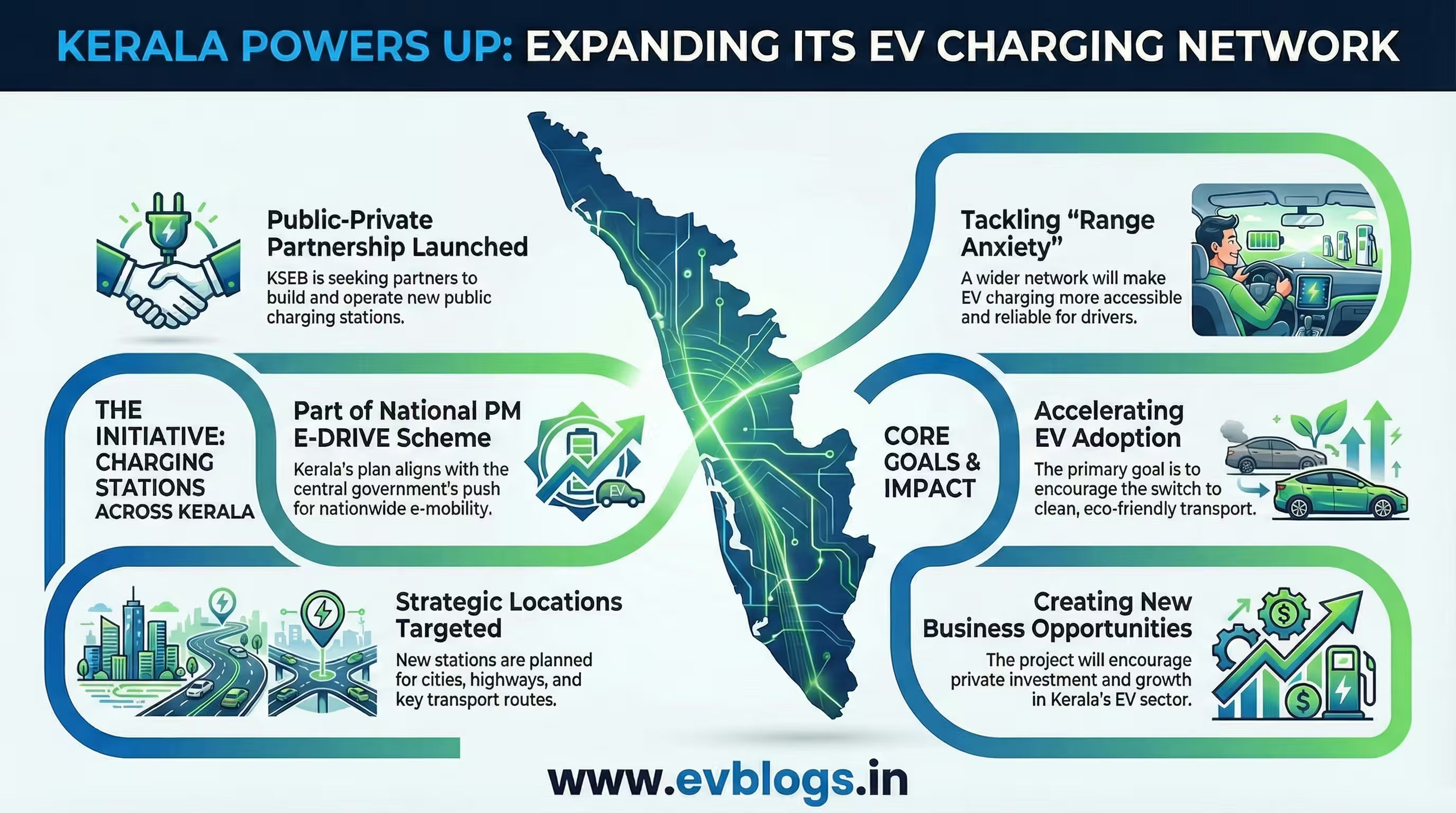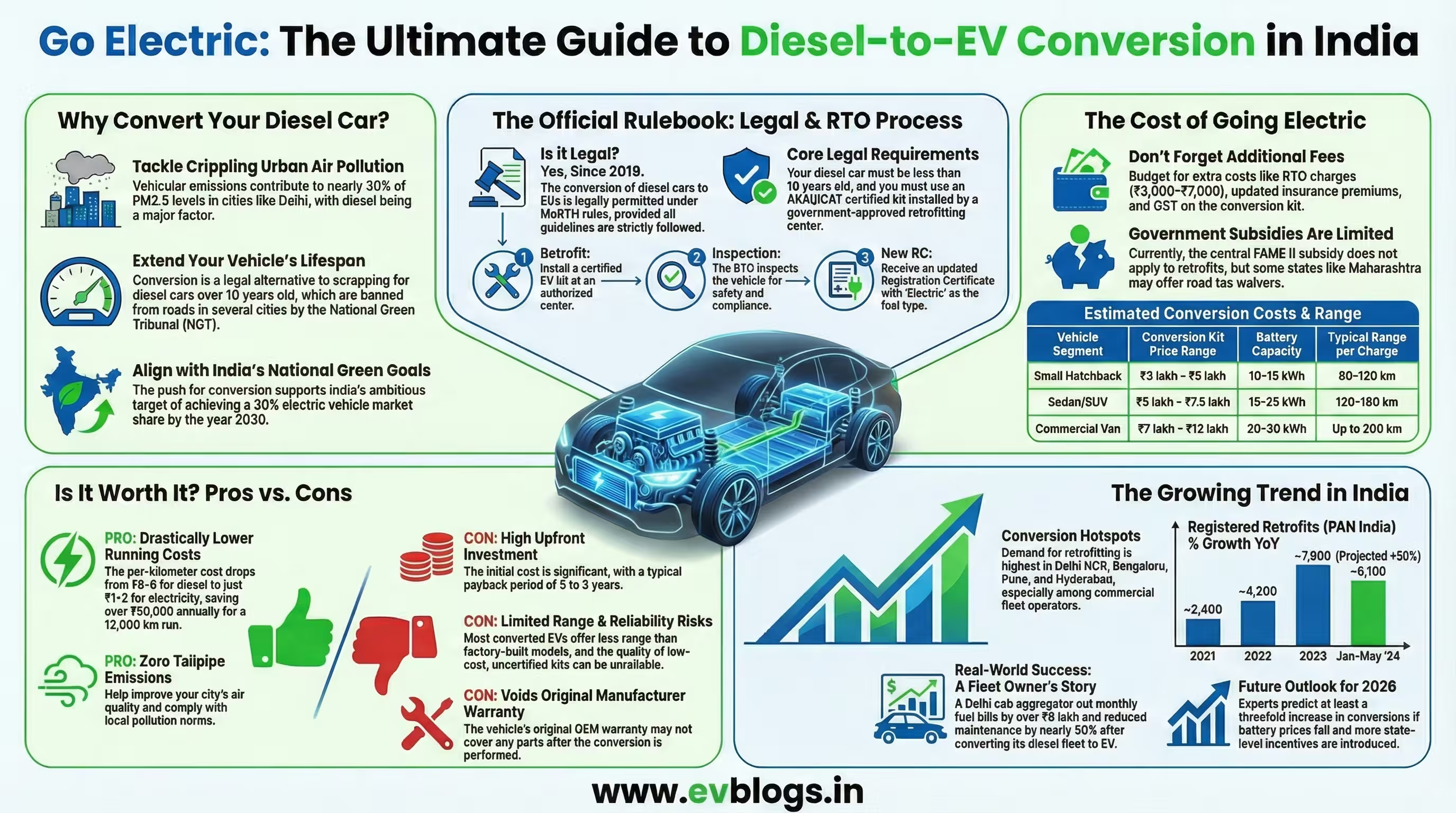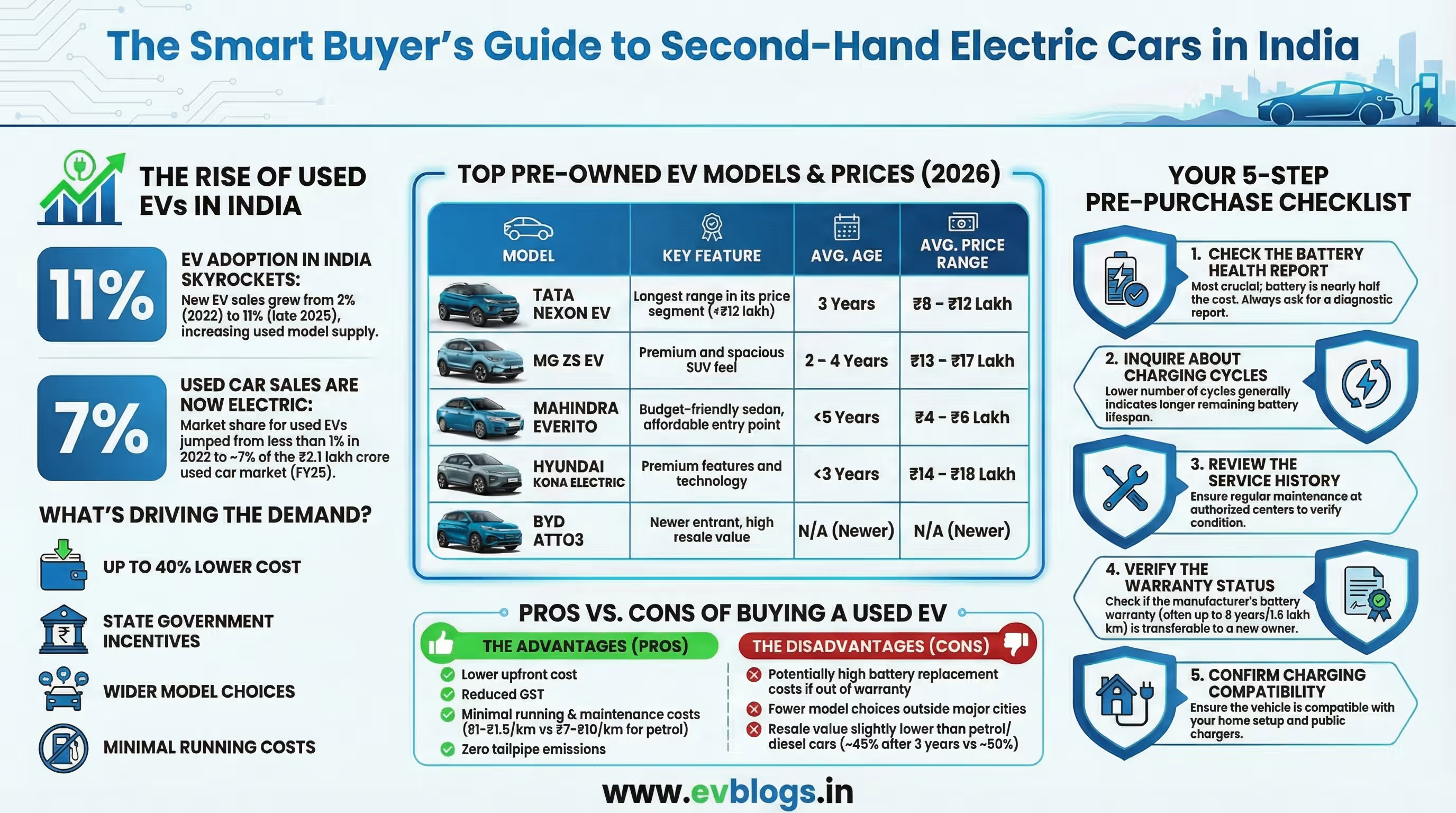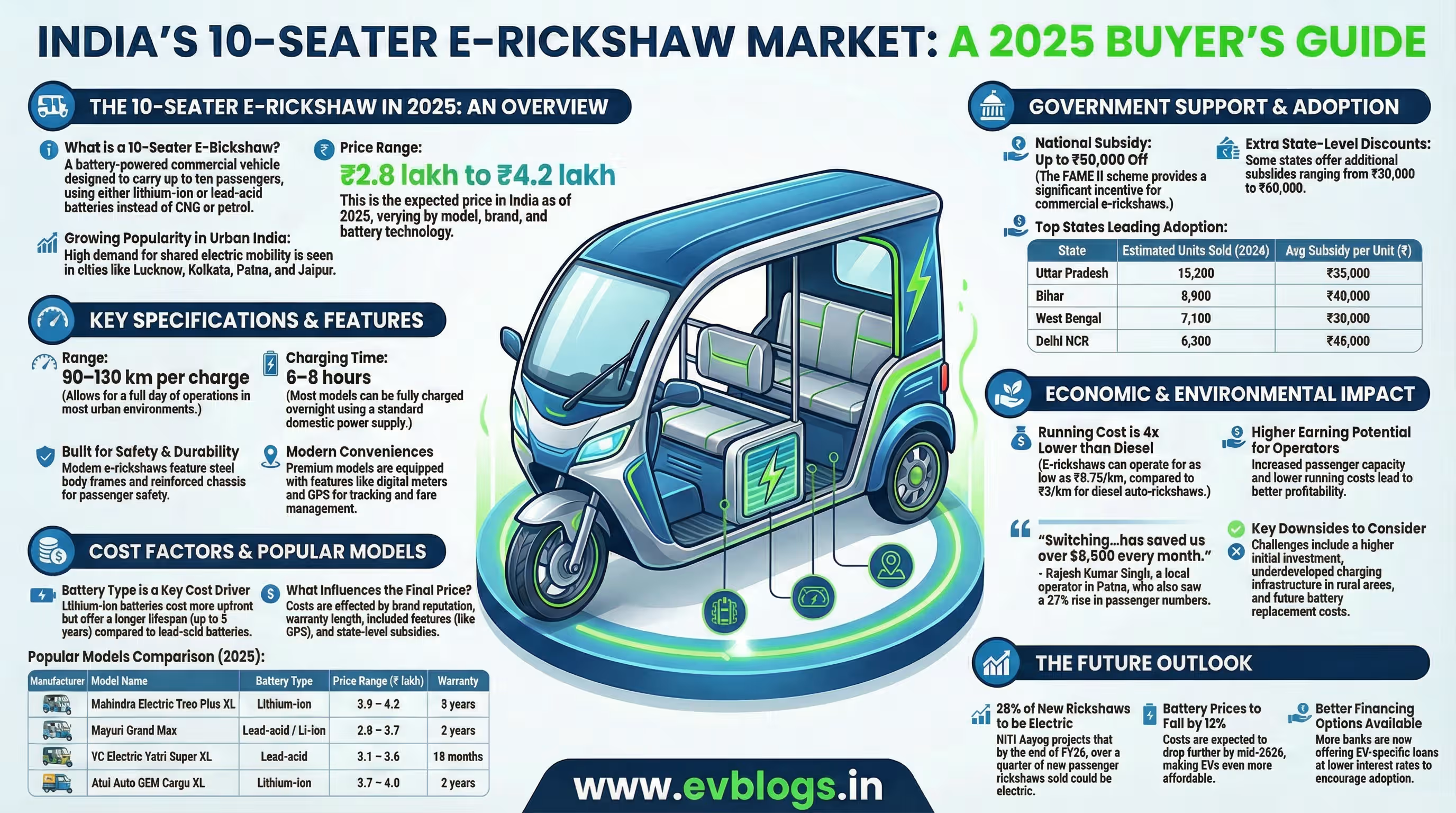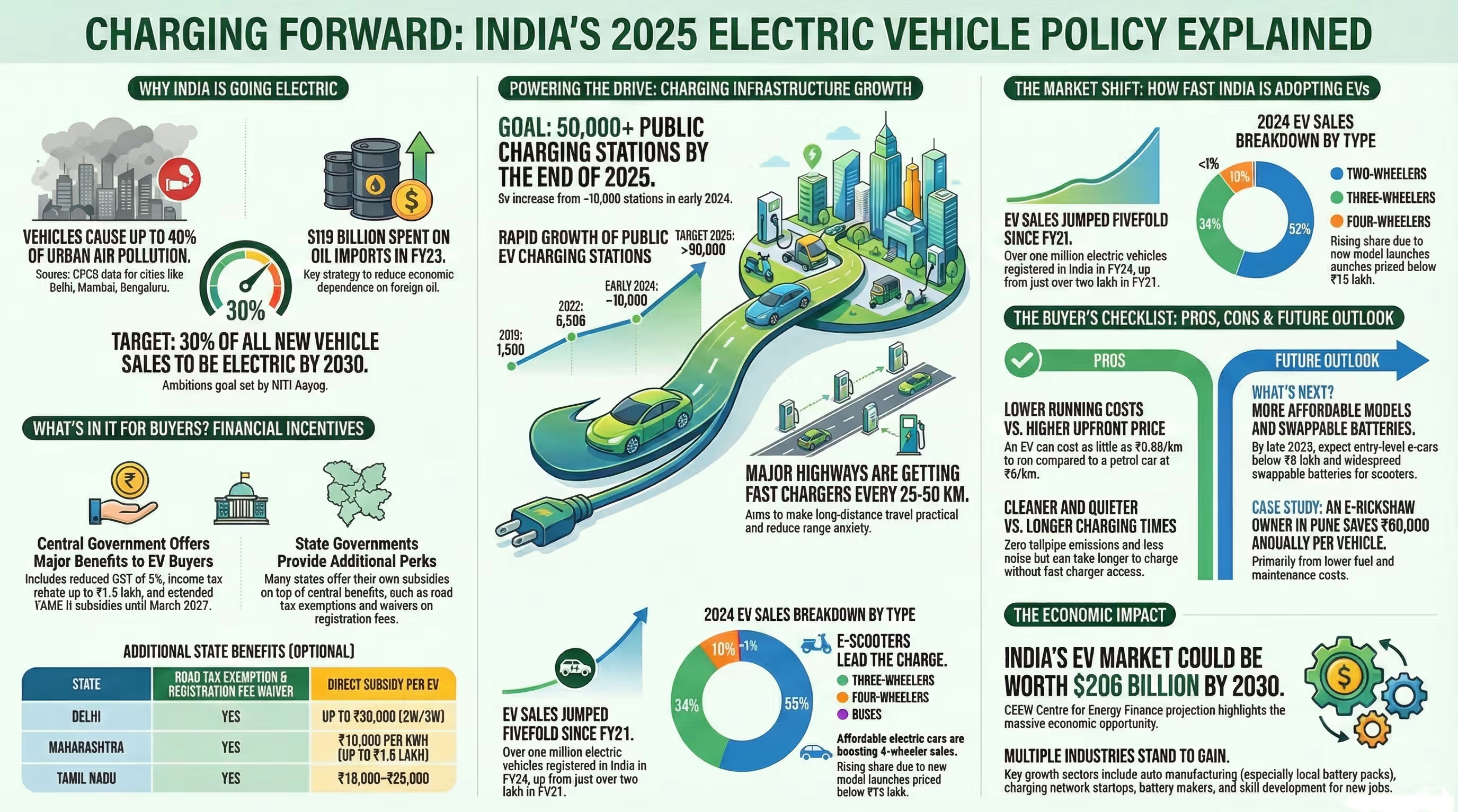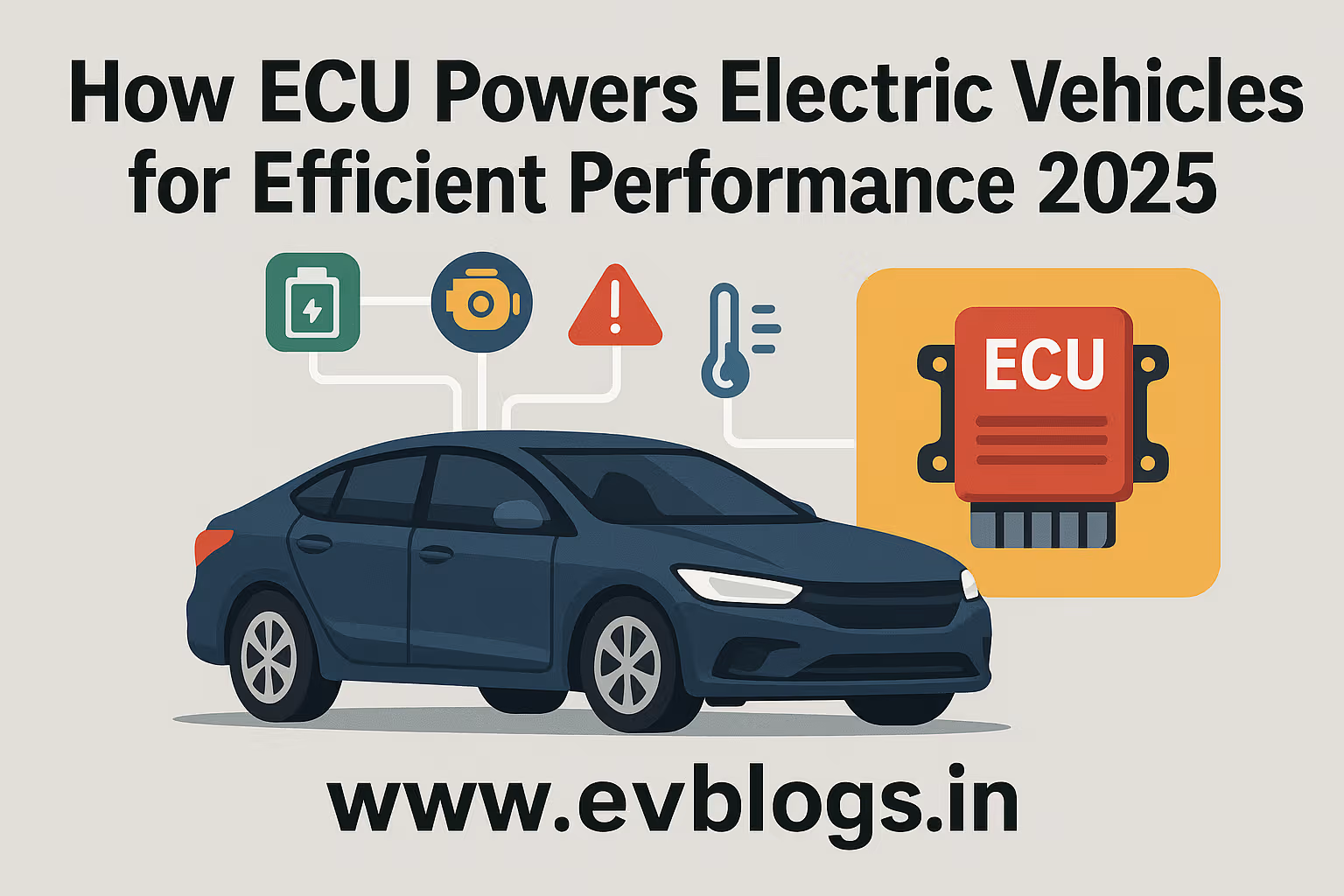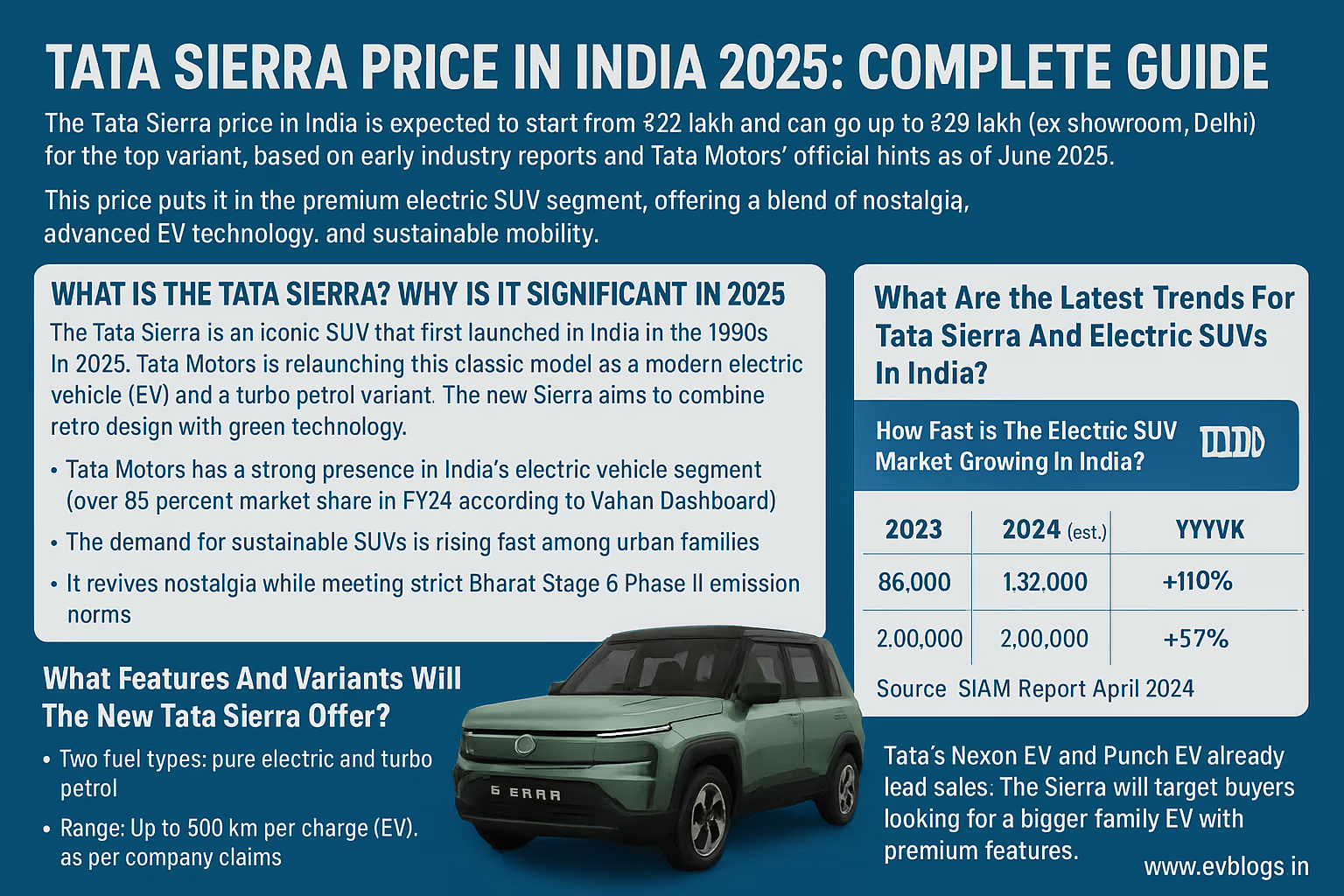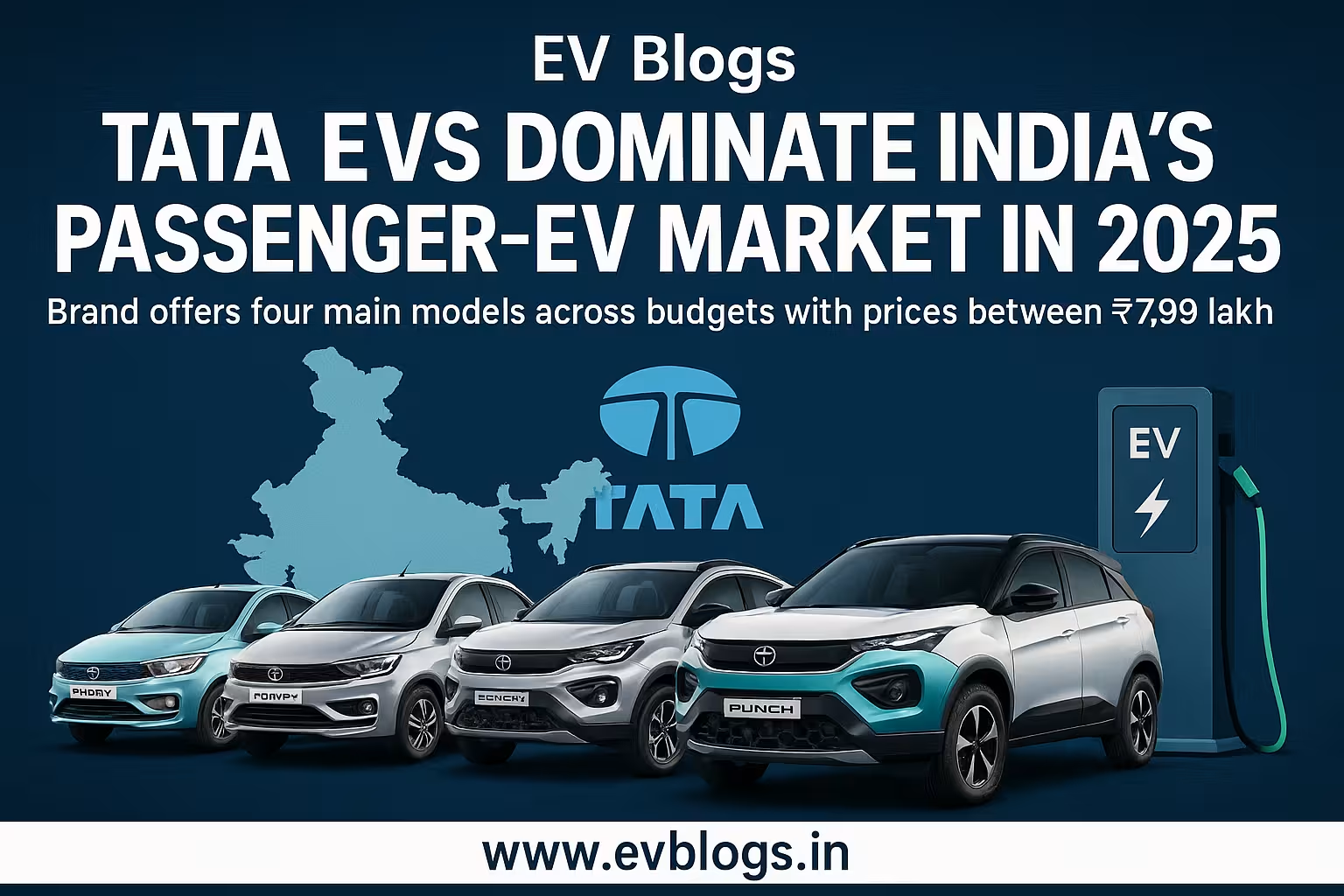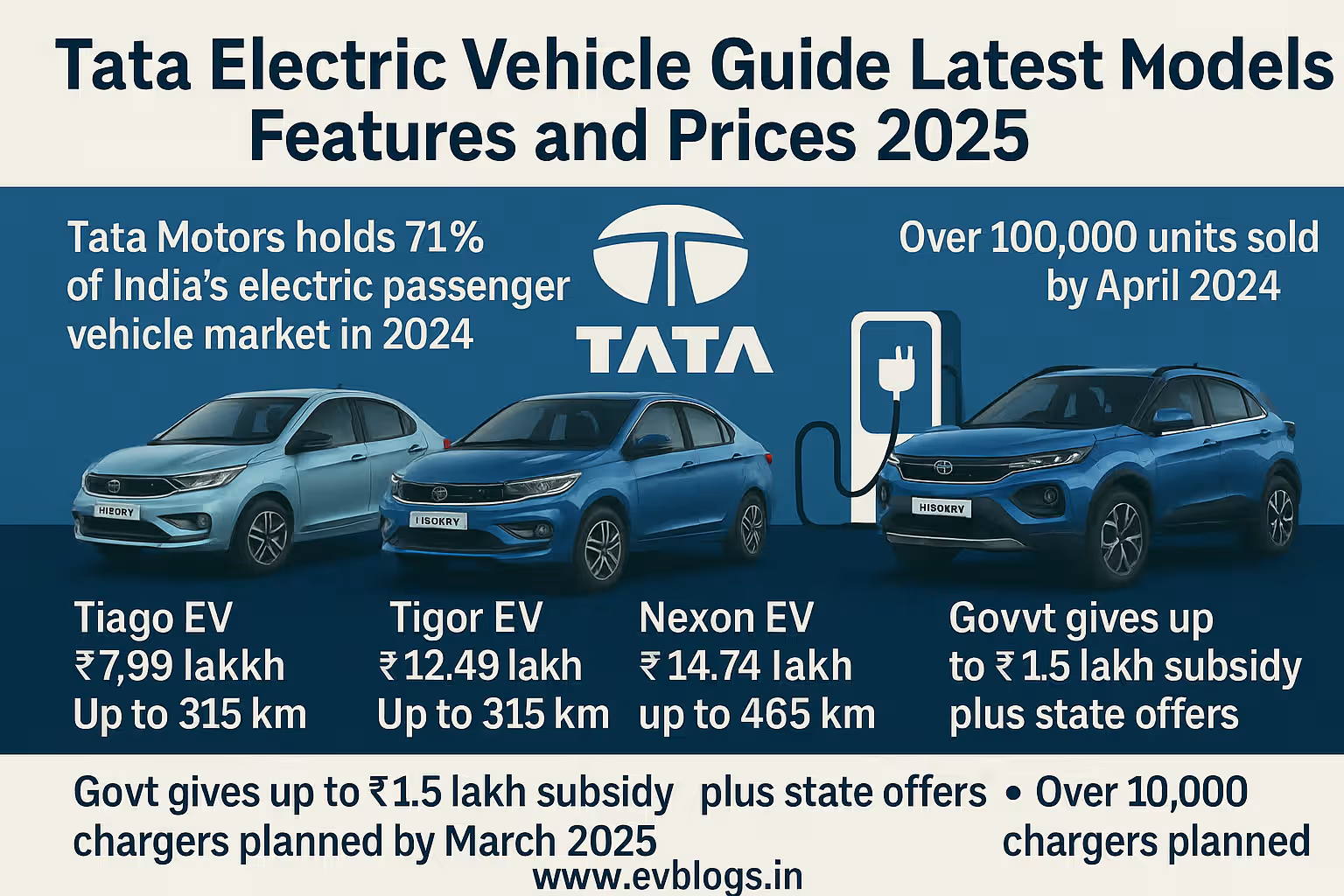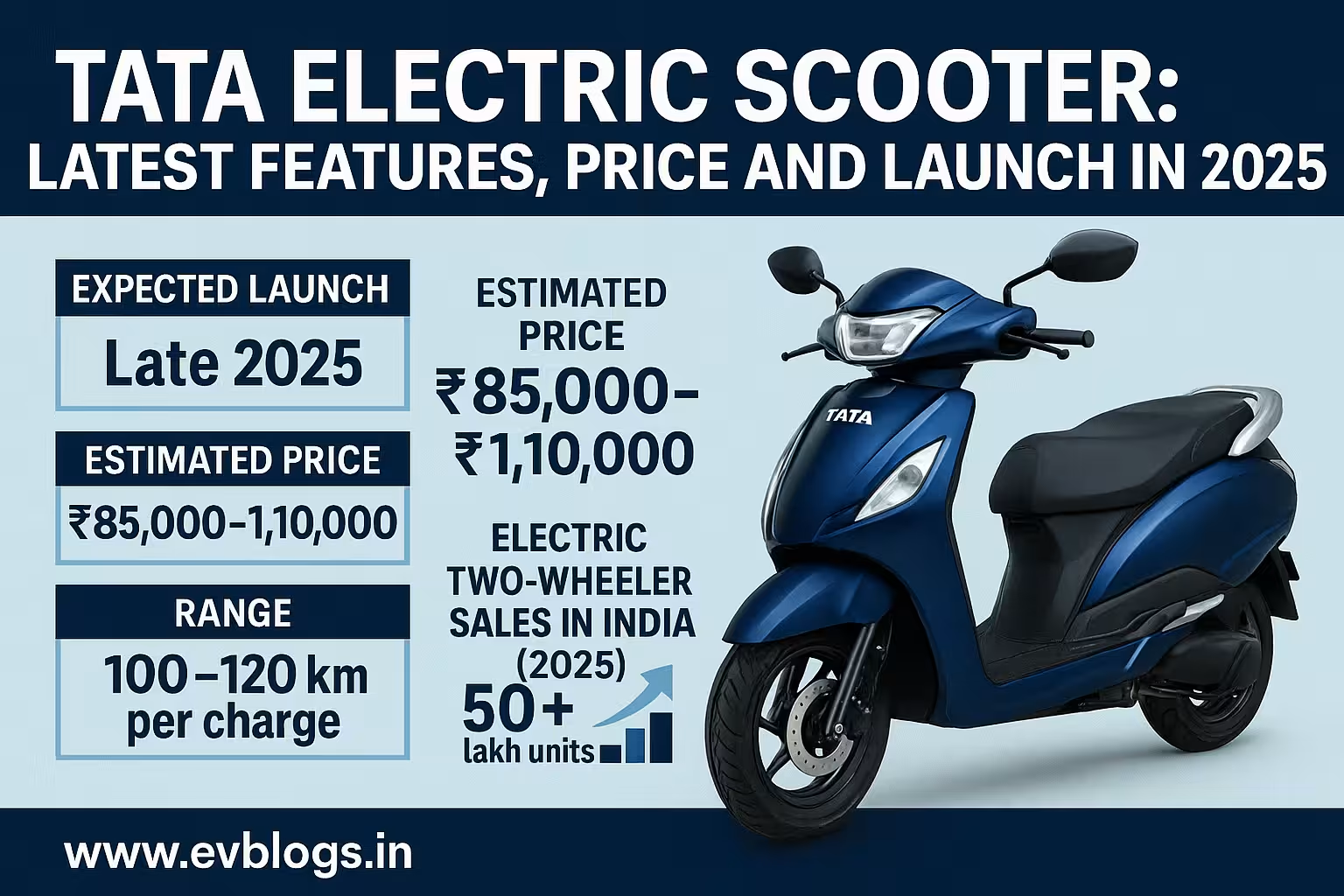Hedhvick Hirav
Hedhvick Hirav is a dedicated EV researcher and editor with over 4 years of experience in India’s growing electric vehicle ecosystem. Their contributions have been recognized in leading sustainability publications and automotive journals.
Summarize & analyze this article with
Choose an AI assistant and open this article directly:
Tip: if the AI doesn’t fetch the page automatically, paste the article URL manually.
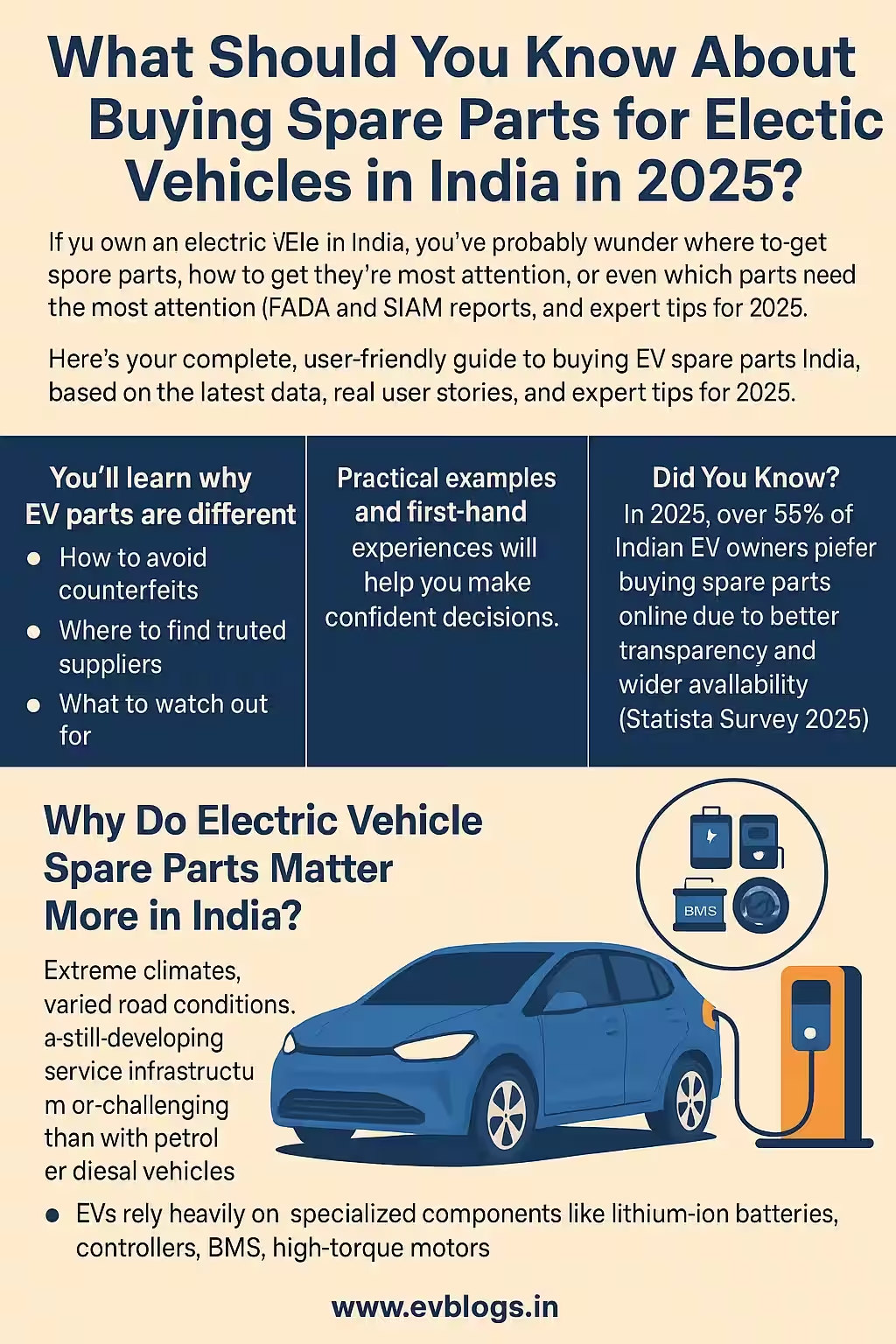
What Do You Need To Know About Electric Vehicle Spare Parts Purchase In India in 2025?
Are you an Indian car owner who owns an electric vehicle (EV)? You must have asked yourself where you can get spare parts and how you can check that they are original, or which parts require most attention, etc. As the Indian EV market is growing at a tremendous pace (the current projections are that it will sell over 2.6 million units annually by 2025 (as reported by FADA and SIAM organizations)) your requirements towards easily accessible, convenient, and low-cost spare parts grow even more. It is a good idea to learn the spare parts ecosystem, whether it is a Tata Nexon EV, an Ola S1 Pro, or a BYD e6. That way, you save money, time, and headaches.
Here is your complete and easy-to-use guide to purchasing EV spare parts in India, according to the latest information, personal experiences, and expert advice in 2025.
- You will understand why EV components are unique, how to beware of fake parts, where to find quality vendors, and what to keep an eye on.
- The first-hand experiences and practical examples will guide you to make sound choices.
- To be on the safe side, buy via trusted dealers or websites.
- In 2025, more than 55 percent of Indian EV users choose to purchase their replacement parts on the Web, as this will result in more availability and transparency (Statista Survey 2025).
Why are electric vehicle spare parts more important in India?
The electric vehicle story in India is peculiar Harsh temperatures, diverse road surfaces, and an immature service ecosystem may make maintaining your EV in good form more tricky than it can be with petrol or diesel models.
- The vehicles are quite dependent on special components, such as lithium-ion batteries, controllers, BMS (Battery Management Systems), and high-torque motors.
- Most regular auto shops might lack appropriate expertise/ diagnostic equipment on these parts.
- Government regulation and FAME II subsidies make parts inexpensive, regarded you purchase them with the right resellers.
Why EV Spare parts Matter in India
- Limited Service Networks: As popular brands such as Tata and Mahindra expand, there are not many authorized electric vehicle service centers in many of the smaller towns.
- Expensive Replacement Parts: An EV battery may cost 1.2-2.5 lakh in 2025 to replace depending on the model.
- Warranty Concerns: The installation of unauthorized parts in an intermingled way can impact your warranty.
- Counterfeit Risk: The Indian automobile industry has been affected by an increase in counterfeited EV parts, particularly those parts that are in high demand and include batteries and motors.
- Upgrades & Repairs: Retrofitting or upgrading (such as a better range batteries) is common, but must be quality components.
Expert Insight
In 2025, more than 18 percent of EV drivers reported difficulties in obtaining genuine spare parts accessible to the inconvenience outside metropolitan areas, according to the Automotive Component Manufacturers Association of India (ACMA).
Which Spare Parts Will be Essential to Indian EV Owners in 2025?
Not every EV component is identical to the conventional cars It is knowing which components wear out or need replacement most frequently that will make you plan ahead
Most Often Replaced EV Spare Parts
- Traction Battery Packs: The costliest part, the battery packs normally require replacement after 7-8 years or anywhere between 100,000-120,000 kms.
- Battery Management System (BMS): Tracks and maintains battery vitality, and is frequently substituted when an error has taken place.
- Electric Motors & Controllers: Life to 10+ years but repair or replacement may be required in extreme use conditions.
- Onboard Charger: AC to DC conversion; can fail due to the variation in voltage.
- Indian Eco-specific Fuses and Wiring: It can be destroyed by rain and Indian heat.
- Touch Screen displays and Infotainment: These may get their screens dirty, overheated, or break.
- Regenerative Braking Parts: The brake parts in EVs are specially designed to last longer than normal brake parts and look out.
- Low Rolling Resistance Tyres: Reduced heat.
The More Unusual (Urgent?) Parts
- Inverters
- Air Conditioning (on battery rack or motor)
- Sensors (Temperature, volt, proximity)
- The HVAC System (Electric A/C compressor)
To be on the safe side, buy via trusted dealers or websites.
Tata Motors have anticipated a reduction of battery replacements of electric vehicles by 40 percent between the year 2022 and 2025 allowing cheaper repairs to their owners (Tata Annual Report 2025).
How can you tell authentic EV had parts in India?
As counterfeits continue to get more advanced, it is important to know what you can do to make sure you are purchasing the genuine article.
The way to identify authentic parts
- OEM Certification: check whether there are holograms, QR codes or serial numbers on the packaging.
- Buy at Authorized Dealers: Start on the manufacturers site to obtain a list of authorized suppliers.
- GST Invoice: Ask to receive an invoice with the part number and GST information on it.
- Examine Packaging Integrity: Original parts are contained in high quality, tamper-sensing packaging.
- Verify through Online Portals: You could cross-verify the serial number on the web sites of these brands.
- Measurements: Examine and compare finish markings and check marks to the original part.
Red Flags Counterfeit Parts
- Distorted low prices
- Offensive spelling/manufacturing faults in packaging
- No money back or guarantee policy
- Seller who could not clarify installation or specification details
Expert Insight
In 2025, Ola Electric partnered with Blockchain-based traceability systems or solutions to help users track the authenticity of spare parts in real-time via their mobile applications.
Where to Purchase the Reliable Aftermarket of EV Spare Parts in India in 2025?
It is as important to find the right vendor as to find the right part These are the best options of purchasing EV spare parts in India in 2022:
Where to purchase the original EV spares
- Authorized Service Facilities: Tata, Mahindra, Ola, MG, BYD, Ather, etc have service centers in most Tier 1 and Tier 2 cities with dedicated service facilities.
- Online Officially Owned Stores: Tata.ev, Ola Electric, and Ather were it possible to sell directly to consumers their pink spare parts online.
- Multi-brand EV Spare Parts Portals: Companies like SpareIt, GoMechanic, and Mobikit have bolstered their 2025 catalogues to include a majority of the popular brand EVs.
- Local EV Workshops: In cities such as Delhi, Bengaluru, and Mumbai, local workshops frequently have in stock common sections–although be sure to inquire about certification.
- Emerging Hyper local Delivery: Local auto repair shops being partnered with proprietors like Rapido and Dunzo offer same day delivery of spare parts in some cities.
What to be Careful of
- Warranty and money back guarantee
- Commentaries and feedbacks
- Installation assistance or referral to the qualified technicians
- Refreshed equipment–2025 models can be equipped with different components than 2023-24
To be on the safe side, buy via trusted dealers or websites.
By 2025, SpareIt highlights that there was an increase of 70 percent in sales of spare parts on EVs compared to ICE vehicles as a result of increased urban demand and improved supply chains.
What are the Top EV Spare Components Brands & Suppliers in India (2025)?
There are lots of new and established brands and knowing which supplier is good to go with can help you keep away unnecessary stress later. The following table compares the top 10 suppliers and brands of the EV Spare parts in 2025.
| Brand/Supplier | Primary Strengths | Product Line | Warranty (Months) | Availability | User Rating (2025) | Delivery Time (Avg) | Remarks |
|---|---|---|---|---|---|---|---|
| Tata.ev Parts | OEM Quality, wide coverage | Battery, Motor, BMS, Accessories | 24 | Pan-India | 4.8/5 | 2-5 days | Best to Tata EV owners |
| Ola Electric | Quick Service, Tech Support | Battery, Display, Controller | 18 | Tier 1-2 Cities | 4.6/5 | Same day-3 days | Best digital verification |
| Ather Energy | Performance Parts, Urban Stock | Motor, Charger, Tyres, Sensors | 24 | Metro Cities | 4.7/5 | 1-3 days | Fastest urban service |
| G eShield | Premium Service, Extended Warranty | Battery, Infotainment, Sensors | 36 | Major Cities | 4.4/5 | 3-7 days | Best warranty coverage |
| BYD India | High Tech, fleet oriented | Battery, HVAC, Controllers | 24 | Tier 1 Cities | 4.3/5 | 5-8 days | Tier 1 urban users of e6 fleet |
| GoMechanic EV | Multi-brand, Budget Friendly | Motor, Wiring, Brake, Suspension | 12 | 20+ Cities | 4.2/5 | 2-5 days | Applicable to non-OEM spares |
| SpareIt | Wide Network, Verified Stock | Battery, Electronics, Tyres | 12 | Pan-India | 4.5/5 | 1-4 days | Best in case of urgent requirements |
| Mobikit | Quick Delivery, Service | BMS, Controllers, Infotainment | 6 | 15 Cities | 4.1/5 | Same day- 2 days | Good at rare spares |
| Bosch eMobility | German Tech, Reliability | Charger, Sensors, Motor Parts | 24 | Metro & Tier 1 | 4.6/5 | 5-10 days | Greatest component quality |
| Mahindra EV Spares | Rural Reach, Warranty | Battery, Drivetrain, Interior | 18 | Pan-India | 4.3/5 | 2-7 days | Robust in rural/utility EVs |
Brand / Supplier Descriptions
- Tata.ev Parts: All Tata EV models can be serviced using official OEM parts supplied by Tata, with the strongest network at your side. The HG IOSIE thermo is a different factory since it is accompanied by a 24-month warranty.
- Ola Electric: Shine in their traceability of every part via digital development, so you know you are not purchasing a fake.
- Ather Energy: Seeks to capture the market of urban residents and economical. Good news to Bengaluru, Pune, Chennai users.
- eShield: MG provides the finest service and 36 months of warranty which is the best in the industry.
- BYD India: The reliable choice of fleet owners and owners with long-range EVs. Expensive, yet good.
- GoMechanic EV: A feasible approach to the routine maintenance and minor parts.
- SpareIt: Is characterized by instant availability and confirmed inventory in India.
- Mobikit: Extremely helpful when it comes to any rare or difficult to come by parts, especially with the BMS and infotainment.
- Bosch eMobility: Extremely reliable using German designed subelements of EV.
- Mahindra EV Spares: Rural customers including e-Verito, e2o and Treo users.
To be on the safe side, buy via trusted dealers or websites.
BT-Ex GMs eShield program in 2025 takes it a notch higher by even covering unintentional damage to parts of infotainment and others using sensors.
What is the Cost of EV Spare Parts of Different Models in 2025?
A major consideration to you as an EV owner: the real cost. The projected pricing of common spares across popular Indian EVs in 2025 is as compared below.
| Model | Battery Pack (INR) | Motor (INR) | BMS (INR) | Onboard Charger (INR) | Display/Infotainment (INR) | Brake Kit (INR) | Other Key Parts (INR) |
|---|---|---|---|---|---|---|---|
| Tata Nexon EV | 1,85,000 | 70,000 | 25,000 | 18,000 | 30,000 | 8,000 | Tyres: 18,000/set |
| MG ZS EV | 2,45,000 | 90,000 | 30,000 | 22,000 | 45,000 | 9,500 | Sensors: 12,000 |
| Mahindra XUV400 | 1,75,000 | 65,000 | 22,000 | 15,500 | 28,500 | 7,500 | Cooling: 13,000 |
| BYD E6 | 2,70,000 | 1,00,000 | 35,000 | 28,000 | 48,000 | 12,000 | HVAC: 20,000 |
| Ola S1 Pro | 82,000 | 35,000 | 8,000 | 9,000 | 15,000 | 4,000 | Tyres: 7000/set |
| Ather 450X | 78,000 | 30,000 | 7,500 | 8,000 | 14,500 | 3,500 | Sensors: 4,000 |
| Torque Kratos R | 86,000 | 32,000 | 7,200 | 8,000 | 14,000 | 4,000 | Tyres: 8500/set |
| Mahindra Treo | 1,25,000 | 48,000 | 17,000 | 13,000 | 17,000 | 6,000 | Tyres: 11,000/set |
| Hyundai Kona EV | 2,95,000 | 1,20,000 | 38,000 | 30,000 | 52,000 | 15,000 | Sensors: 15,000 |
| Citroen eC3 | 1,68,000 | 59,000 | 19,000 | 15,000 | 27,000 | 7,500 | Tyres: 15,500/set |
Key Takeaways:
- The largest expense is the battery pack, particularly of SUVs and luxury cars.
- The costs of replacement are much lower in scooters (Ola, Ather, Tork).
- In premium models, the cost of infotainment and sensors is very high.
- Braking and tyres are about the same, although look out for EV-specific tyres.
Expert Insight
Mahindra XUV400 customers have saved 35 percent in annual running and maintenance costs compared to ICE SUVs, among other reasons, because they have fewer moving parts and less frequent spare parts.
What Are Some Things To Look Out When Purchasing EV Spare Parts Online In India?
You can shop online, which is convenient, but it is also very risky- especially in something as important as an EV.
How to Be Safe Shopping EV Spare Parts Online
- Trust reputable or well-known markets: Do not purchase in deals in little-known sites or social networks.
- Read customer reviews: Pay close attention to the reviews left behind by customers especially on part fitment and after sale service.
- Check company policy on returns and money-back guarantee: Real sellers provide some 7-30 days returnPLUS 2025.
- Check compatibility: Check complete compatibility of your EVs by model and year.
- Make sure the installation support is offered: Certain portals such as GoMechanic and SpareIt can provide doorstep installation via certified installing technicians.
- Avoid “universal fit: EV parts tend to be model-specific.
User Story
Nikhil, who owns a Tata Nexon EV in Pune, purchased a batter management system online but it did not fit his car regarding the software version. The result? His warranty was annulled and he had to part with additional money to substitute that BMS with the corresponding one proposed by an authorized dealership. Lesson: Be careful to check compatibility and to buy only reliable sources.
To be on the safe side, buy via trusted dealers or websites.
By 2025, 9 percent of all EV spare parts purchased via e-commerce sites in India will be returned due to compatibility problems, compared to a higher number in previous years (RedSeer Insights).
What Is the Best Time to Replace and Upgrade Your Key EV Spare Parts?
Most EV components last longer than their ICE counterparts, yet there are others that need a proactive replacement.
Indicators of Upgrading/Replacing
- Battery: Loss of range ( greater than 20 percent) or frequent charging errors or warning lights.
- BMS: No dashboard and charge problems.
- Motor: Rattling or poor-performance.
- Onboard Charger: slower charging, overheating, or failure of charging.
- Braking: Lack of the ability to cease (although braking is made regenerative, pads still wear out).
- Tyres: Damaged tread or sidewall crack (more in EV torque).
- Infotainment/Display: Frozen screen or unrepsonsive controls.
Replacement Periods (Estimated, Used by Indians in 2025)
- Battery life: 7-8 years (or 1,00,000km)
- Motor: 10+ years, seldom replaced, unless abused
- Brake change: 50000Km to 80000Km, depending on usage
- Tyres: 30 000 km to 40 000 km
- BMS and charger: as needed, usually in the case of a major faults
Expert Tip
Battery health checks should be done proactively (every 12 months) so that you have planned on eventual replacement and not unexpected breakdowns.
Expert Insight
In 2025, Ather Energy will use predictive maintenance reminders notifying users of their upcoming spare part requirements and using real-time usage data.
What Is the Process of Warranty and After-Sales Support of EV Spare Parts in India?
Be aware of your warranty cover, and that unexpected costs can be avoided.
- OEM Warranty: Has service on original components in given time frame (usually 2-3 years).
- Extended Warranty: Has a fee; normally covers the electronic components and battery, up to 5 years extra. Components such as the batteries have 8-year warranties as well.
What To Expect?
- Warranty on Replacement Part Most original spares have a 6-24 month warranty.
- Artificial replacements of parts
- Manufacturing defects
- Not due to user abuse Premature failure
- Installation problems (in case fitted by authorized center)
Not Covered
- Accidental damage
- Unauthorized repairs
Urban commuter, 1 (Bengaluru, Ather 450X)
Claiming AZ Gram.
- Retain your original purchase invoice
- Retain receipts of installation (particularly when performed at unauthorized installation centers)
- Submit a claim through the web site or mobile app of the brand
To be on the safe side, buy via trusted dealers or websites.
Both Tata and MG launched digital warranty tracking, where you could review the status of a part warranty on your phone in 2025.
Which EVs in India Offer the Lowest Cost of Spare Parts (2025)?
In terms of cost of ownership, however, there are specific models that are superior in the sense of spare parts price and availability.
- Ather 450X and Ola S1 Pro: Lowest Lifetime spare parts of any scooter, due to locally manufactured scooters with wide support.
- Tata Nexon EV: Lowest tier for an SUV; Tata produces parts in mass amount thus making it easily accessible, and all at a rather good price.
- FAME II Extension: It will now include subsidies on batteries and critical electronics to spare parts, instead of new cars.
- MG ZS EV/Hyundai Kona: Spare parts are rather costly, which is offset by more extensive warranties and high-quality after-sales services.
The List of Models with the most Affordable Replacement Parts
- Ola S1 Pro
- Ather 450X
- Availability in the closest large city (metro v rural)
- Mahindra e2o Plus/Treo
- Tata Nexon EV
- Citroen eC3
Things to consider
- The Fun Fact is…
- Overseas service center network
- Brand has its online and offline layers.
Expert Insight
In 2025, Tata aims to have 48-hour delivery of over 200 EV spare parts SKUs in the top 50 cities in India with its EZ Spare program.
What Is the Role of the Indian Government to the EV Owners in Terms of Spare Part Availability in 2025?
Central and state government policies contribute a great deal in ensuring EV maintenance become a hassle free exercise.
Priority Government Programs 2025
- Standardization: The use of QR code in batteries and high-voltage components is compulsory as per BIS (Bureau of Indian Standards) standards.
How Can It Help You
- Savings on GST: 5% GST on EV spare parts (Up to 28% GST on ICE spare parts).
- State Service Mandates: Delhi, Karnataka, Tamil Nadu require EV brands to ensure that they keep minimum spare parts supply at each regional service point.
- Duty Relaxation on Import: Some EV battery module and electronics component, until March 2025.
Urban Commuter, 1 (Bengaluru, Ather 450X)
- Reduced prices of battery and electronic replacement
- Better availability of real, standard parts
- Less chance of getting stranded because of unavailability of spares, particularly in Tier 2/3 cities
To be on the safe side, buy via trusted dealers or websites.
BIS-certified battery packs in 2025 now have a tamper-proof QR code that allows you to quickly check age, origin, and warranty information.
What is the First-Hand Experience of Indian EV Owners When It Comes to Buying Spare Parts?
The experiences and case studies of direct owner are far more revealing than any brochure or spec sheet.
Required a replacement charger as a result of Stadium power surge
- Purchased Ather APP, found the charger in the service center in town and installed it in 36 hours.
- There were only 3 days of total downtime; it was expensive but was within the price covered by the extended warranty.
- Find support and warranty to be strong, but significantly more expensive than an ICE scooter part.
It had been experiencing a problem in its brake system: the local mechanic had not been able to get authentic parts.
- After 1,10,000 km, I replaced battery module.
- The process of recalibration and warranty documentation was carried out by the authorized center of BYD.
Normal User Themes
Owner story 3: rural (Jaipur, Mahindra Treo)
- Invest in long term warranties: Batteries and controllers are things to consider.
- One eventually decided to use GoMechanics online portal, parts delivered in 5 days, and installation assistance through partner workshop.
Mumbai, Tata Nexon EV: Enthusiast 4
Source upgraded low resistance tyres through SpareIt to increase range.
Saved on dealership markup, but took the time to make sure it was compatible.
Buy, install: Assists with re-sessions and warranties.
The majority of owners are more concerned with speed and reliability than the bottom price.
Cities have quality spare part logistics
The issue of counterfeits and interoperability are still primary factors in Tier 2/3 cities.
Expert Insight
Locally, 89 percent of Indian EV owners in 2025 say they recommend that brand-authorized service platforms be used when buying spare parts, with references to peace of mind and warranty coverage (Local Circles online opinion poll).
What Can You Do to Future-Proof Your EV Spare Part Purchasing in India?
Purchasing EV spare parts is not merely focusing on today it is about looking into the future of your transport. Here is how you can ensure that you are long-term ready.
Future-Proofing Tips
- Keep software current: Certain components (such as BMS or infotainment) will need updates to be current.
What is the next?
- Service bulletins and track recalls: Brands routinely change particulars due to safety concerns, and these changes are frequently free of charge.
- Domestic production (PLI schemes) will be cheaper, and more readily available.
- Be connected to owner communities: For more tips and troubleshooting and rare spares, forums and WhatsApp groups can be invaluable.
Urban Commuter, 1 (Bengaluru, Ather 450X)
- Stay away of unauthorized sources to get some important components (battery, BMS, charger, motor) that can endanger your warranty and safety.
- We will see more brands with maintenance plans in the form of subscriptions that keep the customer topped up with spares and services.
To be on the safe side, buy via trusted dealers or websites.
Towards the middle of 2025, the Indian government will be able to produce 70 percent of all EV spare parts locally which is a significant advancement towards self-reliance and affordability.
Conclusion: How should the sale of spare parts to Indian EV owners in 2025 be organized best?
The India market of spare parts of the EV can be difficult to navigate, but it becomes less so each year. The trick is to:
- Do not use unauthorized sources to receive key components (battery, BMS, charger, motor) that may put your warranty and safety at risk.
- Indicate the use of reputable sources of routine maintenance and less critical components online and offline.
- Use government programs, GST reduction and warranty schemes to save money.
- Be part of owner communities where real-time support and troubleshooting can be obtained.
- Plan and record and double-check compatibility.
Final Verdict:
In 2025, Indian EV owners will be safest to purchase spare parts in brand-authorized centers and through verified online resources. Local and third-party stores have their bargains, but with certification and compatibility, carefully check. It matters a lot to your EV and your peace of mind.
FAQs Indian EV Spare Parts Buying Guide 2025
Q1. Will it be possible to use generic spare parts in my EV to save some money?
Major parts (battery, BMS, motor) are not advised as it may void your warranty and create problems with safety. Less critical parts such as wipers or tyres do not have to be original, however, they need to be authorised.
Q2. In India how much time does it take to get a replacement battery?
Average 3-10 days in metro cities and 15 days in rural areas with most major brands (Tata, Ola, Mahindra) depending on stock and model.
Q3. Will spare parts that are not of the OEM quality cover my insurance claim?
Yes, the vast majority of insurers want to see proof of genuine/OEM parts when it comes to battery, motor, or electrical fires/damage.
Q4. Are spare parts of EV resalable?
Certain components, such as used batteries, can be re-sold to second markets or battery recycling programs. Pre-check on local laws
Q5. Is it safe to purchase EV spare parts in online classifieds or social media groups?
No, unless you can verify the origin, warranty and compatibility. To buy with safety and security, get them through authorized dealers or reputable sites.
Disclaimer Prices, policies, and availability mentioned are accurate as of the year 2025, but could differ by region and brand. Always consult your EV manufacturer or dealer before buying.)
(Disclaimer: Prices, policies, and availability mentioned are accurate as of 2025 but may vary by region and brand. Always verify with your EV manufacturer or dealer before purchasing.)


